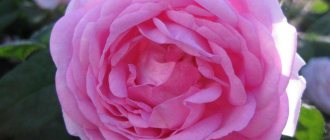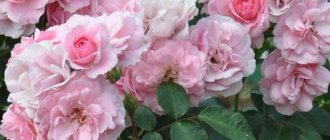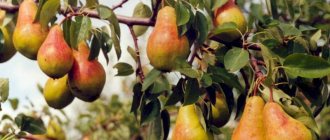Often, beginning flower growers want to purchase unusual flowers that look like peonies, without knowing what they are called. The most popular are peony roses, bred in England at the end of the 20th century. They got their name because of the structure of the flower; the multi-petal inflorescences resemble a lush peony. The bred plant combines decorativeness, unpretentiousness, and high immunity to diseases and pests. By choosing the variety you like best, you can transform your garden plot in a short time.
Peony roses - what kind of variety are they?
Peony or Austin roses belong to the bush and climbing species. The densely leafy plant reaches from 1 to 5 meters in height and 0.7-3 meters in width. The flowers are large, up to 15 cm in diameter. During the flowering period, the buds do not fully open; during wilting, the central petals remain curled.
Peony roses were developed in the 20th century
Depending on the variety, the color of the inflorescences can be very different: pink, white, red, yellow, two or three colors. The flower is spherical in shape and resembles a peony in appearance.
Thin and long shoots are covered with thorns and oblong leaves. The leaf plate is small in size, with jagged edges, and painted in a dark emerald color.
Important! The main feature of the peony species is the subtle aroma of myrrh and vanilla, which is intensely manifested in rainy weather.
Types of peony roses and varieties
Currently, peony roses are not classified as a separate group. They differ from other types in the following parameters:
- flowers similar to peonies are cup-shaped or rosette-shaped;
- the rich aroma intensifies in cloudy weather;
- rapid growth - in a short time the plant forms dense thickets;
- the rootstock never produces wild shoots.
Border roses - what kind of variety are they?
Also, the species is rarely exposed to diseases and pest attacks. Currently, more than 200 varieties are registered, which, despite winter hardiness, require careful shelter. All varieties combine well with each other and look harmonious in the garden.
Important! The rose flower is often compared to peony and ranunculus.
To choose a quality seedling, it is important to listen to the advice of experienced gardeners. The seedling must have dormant buds, no green shoots, a well-developed root system, soft and elastic. The green bark must be free of signs of disease and mechanical damage, and the grafting site must be free of breaks.
Peony rose exudes a pleasant aroma
Reviews from flower growers
Ksenia, 44 years old, Krasnodar region
Austin Mayflower has been growing in my garden for only one year, but has already managed to show its strength and beauty. The height of the bush is more than one and a half meters. The flowers look very delicate and romantic, stay on the branches for about a week, and do not deteriorate from rain or scorching sun. A very beautiful and hardy variety.
Alina, 35 years old, Moscow region
Maria Magdalena is one of the most charming roses in my garden. The flowers are very fragrant, a delicate pinkish-orange hue, gradually fade to almost white - they look delicious. They bloom in a few days, but there are so many buds that it is not noticeable at all.
Olga, 53 years old, Rostov region
The English variety Darcy Bussell is simply magnificent. The flowers are large, ideally shaped, rich red-raspberry color, with a pleasant fruity aroma and, most importantly, do not droop, but always look up. The bush is healthy, blooms profusely, new buds appear all summer, the flowers last a long time and are not afraid of rain.
Pink peony roses
David Austin roses - the most popular varieties
The pink appearance is characterized by the splendor and tenderness of the flower. Depending on the variety, the flower can be double, differ in size, density of petals and color range (from pink, cream to peach).
Constance Price
To obtain the variety, scientists crossed the Gali rose with the modern flaribunda. The plant turned out to be strong, more than 4 meters high. Since the shoots are highly developed, the rose needs support.
The soft pink or caramel terry inflorescences are large, up to 13 cm in diameter, and exude a pleasant aroma. Thin and long shoots are covered with thorns and large dark green leaves. The culture blooms well and reproduces even in regions with an unfavorable climate.
The variety reaches 4 meters
Eglantine
The bush peony-shaped rose-shrub blooms throughout the warm season, but with improper care and in rainy weather it often gets sick. Therefore, the variety is suitable for experienced gardeners. When planted in open sun, the flowers quickly fade and the petals turn from soft pink to off-white.
The variety has a pleasant, delicate aroma, which is intensely manifested in the evening. The shape of the flower is original - it is somewhat similar to porcelain glasses. The rose should overwinter under cover, since slight frosts can destroy the bush.
Only an experienced gardener can grow the plant.
Miranda
The variety is young, bred in the UK in 2005. The plant is distinguished by the color of its inflorescences: the outer petals are light pink or white, and the central ones are pale pink. Flowers 12 cm in size, without a rich aroma, are formed on a compact bush about 150 cm high, no more than half a meter wide. Single flowers are suitable for cutting and making bouquets.
The variety is resistant to temperature changes, grows and blooms well in partial shade, and is immune to diseases and pests.
Rose bred in England
Excursion into history
British botanist David Austin perfected the English rose garden queen flora.
The reason for the idea was factors that clearly did not satisfy the young plant grower - rather time-limited flowering, susceptibility to infections. The goal was the desire to create perfect varieties of a new type, combining the classics with a hybrid tea variety.
The task at hand required hard work and careful research. As a result of long-term development, humanity has acquired several improved samples of what was planned.
The seventies of the last century were marked by success, the scientist’s dream came true.
White peony roses
There are few white hybrids. Despite this, they are very popular among gardeners, as they not only decorate the garden plot, but also exude a pleasant aroma.
Snow Goose
Orange roses - description of the best varieties
A tall shrub with snow-white or cream narrow-petaled flowers, up to 5 cm in diameter. With timely care, it grows in width by 1.5 m and reaches a height of up to 3 m. The inflorescences are collected in a raceme, which contains from 5 to 7 buds. The thornless shoots are covered with small, dark green leaves with jagged edges. Flowering is long and lasting.
Important! The peony rose variety Snow Goose blooms profusely and for a long time only in regions with a hot climate.
Tall shrub used for vertical gardening
Tranquility
The variety belongs to the musky species. The buds are 11 cm in diameter and have a neat round shape. The variety has one peculiarity: when closed, the petals are cream-colored; as they bloom, they become pure white.
The plant forms a semicircular bush up to 0.5 m high. Erect shoots are covered with small matte dark green leaves.
Important! A distinctive feature of the variety is the absence of thorns on the shoots.
Variety with thornless shoots
Claire Austin
A stunning variety with cup-shaped buds of snow-white color with a creamy tint. The plant forms a medium-sized shrub no more than 1.5 m high. With the onset of warm days, 3 small buds with a diameter of about 10 cm are formed on each erect shoot.
Important! The variety is resistant to diseases and pests. With timely care, the shrub blooms 2 times a year.
The variety is resistant to diseases
Modern varieties
Modern varieties of roses include: floribundas, climbing roses (climbers and ramblers), hybrid tea roses, ground cover, miniature and scrubs.
Climbing types of roses grow up to 4 m in length, the buds are collected in inflorescences. Ramblers have flexible and climbing stems, they are placed on supports. Small buds bloom profusely once a season. Climbing climbers have a thick stem and large buds that delight with continuous flowering. Popular varieties are Elfe, Jasmina, Michka.
The best hybrid tea roses are shrub roses. They have smooth or spiny shoots with a small number of reddish spines. Lanceolate leaves are shiny light or dark green. The bud petals are dense or semi-double and smell of spices and Chinese black tea. There are three flowers in bunches, and they bloom in pastel colors: white, pink, yellow and apricot on new or last year's shoots during the summer. But there are rich red, almost black flowers with a variety of light and elusive, rich and dense aroma.
What are the typical tea grade roses? They are distinguished by pointed buds that form flowers that form a spiral of petals with curling edges. That's why the flower has a pointed top. Popular modern varieties include: Duchesse de Brabant, Lady Hillingdon, Maman Cochet, Mrs. Foley Hobbs, Advance, Black Baccara, Topaz, Hommage a Barbara, Wow, Papillon.
Floribunda looks like a hybrid tea, but it blooms for a long time, and sometimes continuously. The flowers have no aroma; they can be simple, semi- or densely double, and are collected in a bouquet of inflorescences. The buds resemble a bowl or glass. The plant is frost-resistant.
The ground cover variety was introduced from climbing old garden roses. Long drooping stems creep along flat or rocky ground. The height of the bush is much less than its width. This species can decorate any landscape and be combined with other flowers and plants due to the variety of shades of medium-sized flowers. Beautiful roses have become popular varieties: Euphoria, Purple Rain, Satina.
Blue roses occupy a special place among hybrid teas. The blue tint of the flower is obtained due to a special pigment - delphinidin, obtained through long-term selection. Particularly popular:
- "Blue Perfume" with purple-lilac or lavender buds and a pronounced aroma. At first, the flower, measuring 10-11 cm, acquires a purple color, and when fully opened, the inner petals become raspberry or lavender in color. The petals have special, slightly torn edges. But, despite the coloring, this variety is classified as a blue variety. Dense leaves of dark rich color. The shrub is beautiful and compact, densely branched, reaches a size of 60x60 cm, blooms until autumn frosts, and is not afraid of disease and cold.
- "Blue Moon" with an unusual lilac-blue color. The petals are blue: indigo and soft heavenly. The bud consists of 25-30 petals, forming a double flower, 10 cm in size. The bush reaches a height of 250-300 cm, a width of up to 75 cm. It can withstand frost up to 35°C, and has average resistance to disease and rain. It blooms twice per season and exudes a citrus aroma. The plant requires supports of different designs.
Yellow peony roses
Thanks to the work of English breeders, peony roses with yellow petals were born. Such varieties are loved by Russian flower growers for their unpretentiousness and resistance to sudden temperature changes.
Golden Celebration
This wonderful variety is distinguished by lush flowering and large inflorescences with a diameter of up to 16 cm. Flowers are collected in groups of 3-4 pieces. Honey-lemon roses exude a pleasant aroma.
The peony bush rose reaches a height of 1.5 m. The thorny shoots are curved and covered with dark green bark. The variety is resistant to sudden temperature changes and diseases. Flowering lasts throughout the entire warm period.
A wonderful plant with lush flowering
Graham Thomas
The variety is young, bred in 1983. Thanks to its double fragrant flowers, the plant has gained great popularity among gardeners. The inflorescences are large, 10-12 cm in diameter. The petals are canary-colored with a peach tint. The rose bush blooms from the beginning of summer until the first frost. Inflorescences are collected in brushes of 3-5 pieces.
In regions with cold climates, the rose bush reaches 1.5 m; in southern cities, the plant grows up to 3 m. The variety is resistant to temperature changes and has strong immunity to diseases.
Important! The Graham Thomas variety is the best variety of D. Austin.
The variety is resistant to temperature changes
Damage, prevention, treatment
Austins are quite resistant to many diseases. However, examination for ailments is necessary.
An abundance of dampness, elevated temperatures, direct sunlight for a long time, a lot or, conversely, a little fertilizer, improper pruning are factors that contribute to the occurrence of infectious, fungal diseases.
Popular ones are:
- black spotting;
- gray rot;
- viral mosaic;
- powdery mildew;
- rust.
Signs of damage that appear require immediate intervention. In order for David to continue to enjoy his triumph, dense bushes must be avoided.
Prevent drying out of the soil cover; spray and water only in dry weather. Having opened the shoots after winter, you should not place covering devices nearby. When checking their well-being, you should cut out damaged, dried branches.
Nitrogen additives should be administered in limited quantities. By taking all preventive measures, the health of your pets is guaranteed.
If the bones are sick, use a soap solution from folk remedies, or Bordeaux liquid from professional preparations. An effective, affordable, universal panacea that can improve the health of sick units.
Red peony roses
Red roses are a symbol of love and passion. They are used to decorate personal plots, as well as to make bouquets.
William Shakespeare
Densely double and very fragrant flowers, 8 cm in diameter, collected in brushes of 3-5 pieces. The color of the petals depends on the growing conditions and can be scarlet or purple.
The plant forms a powerful bush up to 2 meters high. The variety is resistant to diseases and sudden temperature changes. Blooms abundantly, 2 times a season. The first wave occurs at the beginning of summer, the plant blooms again at the end of July.
The plant forms a powerful bush
Benjamin Britten
A popular variety with cup-shaped double inflorescences of red color with an orange tint. During flowering, buds up to 12 cm in diameter do not fully open. The plant forms a compact bush up to 1 meter high. On the shoots, flowers are arranged in groups of 3-5 pieces. During flowering, the area is filled with a strong aroma.
The variety is suitable for decorating the garden; it is also planted next to other roses of a lighter color. Flowering is long-lasting, but not abundant.
Popular variety with double flowers
Othello
The variety looks very effective. During the flowering process, the petals change color from juicy lemon to deep lilac. The plant is small and compact. The dark green shoots are covered with thorns and pistachio leaves.
Flowering is abundant and long lasting. The variety is resistant to cold, diseases and pests. Cut flowers are used to make bouquets.
The bush is small, compact
Tradescant
These peony roses are the darkest in color.
At the beginning of flowering, the petals are dark red; as the bud opens, it becomes burgundy, almost black. The inflorescences are small, 7 cm in diameter, collected in clusters of 3-5 pieces. Thin, strongly curved shoots 60 cm long are covered with thorns and light green leaves.
The variety with the darkest petals
Description and characteristics
A description of peony roses will help you understand the characteristics of the culture. David Austin varietal plants are distinguished by the fact that they have a special calyx. The outer petals are normal, but in the middle they are twisted, as if clenched into a fist. The glass is wide and dense. The flowers are fragrant, stay on the plant for a long time, and do not fall off. The height of the peony-shaped “awns” depends on the type and variety.
Attention! Peony roses are called “ostiny” after the name of their creator.
The characteristics are as follows:
- bushes grow quickly;
- having high immunity, they hardly get sick and are rarely affected by pests;
- David Austin peony roses are unpretentious and easy to care for.
Important! The bred varieties of peony roses received their name for the similarity of flowers with double peonies.
How to care for roses that look like peonies
Peony roses are unpretentious. But in order for the plant to delight with its flowering for a long time, it is necessary to follow the rules of care.
Watering rules and humidity
Watering is carried out with warm, settled water as the top layer of soil dries. At least 5 liters of water are used for one bush plant; a peony climbing rose will need about 15 liters. Irrigation is carried out in the morning or evening, trying not to get on the leaves and buds.
Fertilizing and soil quality
For abundant, long-lasting flowering, the plant is fed with nitrogen and phosphorus-potassium fertilizers. At the end of summer, fertilizing is not applied so that the shoots have time to become woody and prepare for hibernation.
Important! Peony rose prefers to grow in nutritious, well-drained soil.
Pruning and replanting
To give the bush a decorative appearance, it must be pruned. This is done before the buds open, immediately after removing the cover. The plant is carefully inspected and dry shoots that have not overwintered are removed. Healthy branches are pruned by 1/3 of the length to healthy tissue. Border varieties are cut to a height of no more than half a meter.
Transplantation is carried out once every 5 years. To do this, the plant is carefully removed from the ground and transplanted to a new prepared place. The width of the hole for planting should be at least a meter, and the depth - 50 cm. The bottom is covered with rotted compost and drainage.
Important! In order for the rose bush to safely survive the cold, the seedling is buried 10-15 cm.
Breeding peony roses
Peony roses are propagated by cuttings and cuttings. You can also propagate the plant by seeds, but this is a complicated matter and often does not bring the desired result.
Cuttings
Ripened but not yet lignified cuttings are cut in August. Before planting, the lower leaves are removed and the cut is made oblique. The cutting is buried at an angle into the soil and covered with a glass cap for rapid root formation.
All winter it is necessary to monitor the soil moisture and regularly ventilate the cuttings to prevent them from rotting. With the arrival of spring, the plant will begin to grow and begin to intensively increase its green mass. After a year, the rooted roses can be planted in the garden.
Cuttings are taken at the end of summer
Reproduction by taps
Reproduction occurs in the second half of summer. To do this, a long, healthy shoot is placed in a prepared trench, leaving the top above the surface of the earth, sprinkled with earth and shed generously. In the spring, after rooting, the branch is separated from the mother bush and transplanted to a prepared place.
Important! Reproduction by vaccination should only be carried out by a specialist.
Care and planting
Before you choose a peony rose, you need to know that these flowers need nutritious, loose soil. Therefore, to begin with, the planting site should be prepared by digging up the area for roses in the fall and adding compost or manure there.
Peony roses can be planted both in spring and autumn, the main thing is good soil. Roses love light, so the location should be chosen with this in mind. The holes for seedlings should be large enough and located at a distance of at least 0.7 - 1 m from each other so that the bush roses do not interfere with each other. When planting, grafting a seedling must be above the soil level.
Caring for peony roses is quite simple. Roses should be pruned in the spring, fed with phosphorus and potassium during flowering, and watered quite intensively, avoiding overwatering.
Roses must be covered for the winter; English sissies cannot tolerate severe frosts. Cover the roses by bending them to the ground and covering the roots with sawdust. The shoots themselves should be covered with covering material.
https://moyadacha.temaretik.com/2030443127864560173/pionovidnye-rozy-vidy-i-sorta-s-foto-uhod-i-posadka/
How to use in landscape design
Peony roses are great for decorating garden plots. They are planted in single groups or in combination with perennial plants with simultaneous flowering. Tall and park varieties are suitable for creating hedges and vertical gardening. Medium-sized ones look beautiful next to phlox, aconite, and sage. The foreground of the flower garden is decorated with border varieties.
Important! Austin rose looks harmonious with hybrid tea and large-flowered varieties of roses.
Peony rose goes well with perennials
The peony rose is a good find for gardeners, as it is unpretentious, blooms long and profusely, and is immune to diseases and pests. But before purchasing a seedling, it is important to find out which variety will be adapted to climatic conditions, since not all plants can withstand cold winters.










